hysteric wrote:Any takers?
Where do you want it to go turbulent?
Hysteric
Do you want it to go turbulent? What you do not want is it to hit the transition area between Laminar and Turbulent in the area where the most load is seen.
Walter hit it, you want it to be enough to not be a significant restriction to fuel flow, to do this it must be larger than the main jet. With a downleg keeping the size from going too big and making flow through the booster too slow is important as well. What I see typically with 4150's on gas is .040" to .060" larger than the main jet with a downleg. I have seen more, a 4781 850 is about .080" more, with methanol some 4150's may get under .040", as .190 is the maximum safe passage size. With a downleg I like to see around .050 from what I think is the target jet will be. I think the 850 may have been better suited with around .160, as at .180 I can get plenty of E85 through the stock booster.
Dominators with annulars are typically .030 to .060 larger than the target jet size, a .160 to .170 booster pin and banjo passage will cover gas from a 1050 to 1250. E85 will run from .180 to .200 in those carb ranges, methanol from .200 up to the maximum diameter you can get a methanol pin, somewhere around .218 to .224. This is part of the issue with getting sufficient fuel through a Dominator on methanol, there just isn't enough material in the banjo and booster pins to go any larger. There are other ways to add fuel, and with more resources ($$$) there are some other possibilities. Braswell has a booster banjo and pin for their large format carbs that has a .250 passage, and with some work could be adapted to a Holley.
Someone made the comment on mainwells, the mainwell itself is usually capable of passing enough fuel, and also needs to be larger than the jet. Most are tapered, although I'm not convinced it needs to be. Taper in the stock metering blocks was there to allow the die casting pins to be extracted, without a minimum taper the pins would get stuck. Gas blocks are typically a #2 taper, roughly around .165 at the bottom and .190 at the angle channel. 3 circuity blocks with an idle tube are usually a #3 taper, around .185 at the bottom and .210 at the angle channel. Methanol blocks vary depending on the builder, the minimum on a 4150 I have seen is the #3 taper, most are at or over .200. E85 varies from a #2 up to a methanol passage depending on the size of the carb.
Angle channels I try to make just a little smaller than the booster passage, so that turbulence is minimized at the entrance to the booster.





